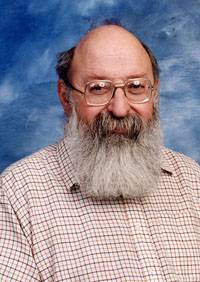Sidney Michaelson
Born May 12, 1925, London; died February 21, 1991, Edinburgh, Scotland; British computer scientist who first applied computers to the identification of the authorship of manuscripts-and in particular books of the Bible.

Education: BSc (1st class hons.), mathematics, Imperial College, London, 1946.
Professional Experience: associate of Royal College of Science, Imperial College, London, 1945; research assistant, applied physical chemistry, Imperial College, 1945-1947; senior mathematician, Electrical Research Association Laboratories, Perivale, Middlesex, 1947-1949; lecturer, mathematics, Imperial College, 1949-1963; director of computer unit, University of Edinburgh, 1963; head, Department of Computer Science, University of Edinburgh, 1966-1975; professor of computer science, University of Edinburgh, 1966-1991.
Honors and Awards: Royal Scholar, Manchester, 1943; fellow, Royal Society of Edinburgh, 1969; fellow, Royal Society of Arts (London), 1979; fellow, British Computer Society, 1980.
Born and brought up in the East End of London, Sidney Michaelson gained his university education by winning a scholarship to Imperial College, London. He graduated in 1946 with a first-class honors degree in mathematics, and planned to work as a mathematician in the aircraft industry. When this plan was thwarted, he undertook a series of research jobs at Imperial College and at the Electrical Research Association Laboratories before taking up a lectureship in mathematics at Imperial College in 1949. There he worked with KD. Tocher on the design and construction of digital computers. Although the only technology available to them was very elementary (telephone relays and uniselectors), they built a working machine (ICCE1) based on a principle, subsequently known as microprogramming, which has become the cornerstone of the design of almost all digital computers [The general credit for the creation of microprogramming is given to Maurice Wilkes (see biography herein); there are three other pioneers who had similar ideas-William Tocher, Michaelson, and I. J. Good. As with so many other creations, the time was right, the need was present, and the supporting science was in place to develop an additional step forward in technology.] His natural modesty led to this work being largely unrecognized.
After a number of productive years pursuing the use of computers in numerical analysis, he was invited in 1963 to establish a Computer Unit at the University of Edinburgh. This became the Computer Science Department in 1966, and he was given the chair of computer science. His attention then turned to the development of systems software for computers. His vision of polymorphic computer systems was many years ahead of the available technology and has only recently been achieved in full with the development of networks of workstations. Nevertheless, he and H. Whitfield initiated significant research activity jointly with English Electric Computers to develop a multiuser operating system, common now but breaking new ground then. This system, EMAS, remained in use within Edinburgh University for an unprecedented 20 years.
Michaelson's personal and enduring passion was stylometry, in which his seminal work with Andrew Morton was particularly exciting and rewarding. Stylometry has been defined as the scientific study of the usage of words in an attempt to resolve literary problems of authorship and chronology. Morton and Michaelson used stylometry to cast light on the authorship of texts ranging from the Bible and the Iliad, through Elizabethan and Jacobean drama, to modern criminal "confessions."
Nationally, Michaelson played a leading role in establishing and maintaining professionalism within the British Computer Society. He always believed that computing was essentially a practical subject, and he was one of the dedicated band of computing professionals who worked hard to ensure that the society became a recognized institution within the Engineering Council.
Sidney Michaelson was never a dull character; he had a wicked sense of humor and it was sometimes difficult even in the most impassioned of arguments to know whether he was serious or not.
BIBLIOGRAPHY
Significant Publications
Michaelson, S., A.Q. Morton, and N. Hamilton-Smith, "Fingerprinting the Mind," Endeavour, 1979.
Michaelson, S., A.Q. Morton, and J. David Thompson, "A Critical Concordance to the Letter of Paul to the Galatians," The Computer Bible, Vol. 21, Biblical Research Associates, Inc., 1981.
Morton, A.Q., S. Michaelson, and J. David Thompson, "A Critical Concordance to the Acts of the Apostles," The Computer Bible, Vol. 7, Biblical Research Associates, Inc., 1976.
Morton, A.Q., S. Michaelson, and J. David Thompson, "A Critical Concordance to I and II Corinthians," The Computer Bible, Vol. 19, Biblical Research Associates, Inc., 1979.
New content Copyright © 2013-2023 by the IEEE Computer Society and the Institute of Electrical and Electronics Engineers Inc.
All rights reserved. This material may not be reproduced or redistributed without the express written permission of the copyright holder.
